Southern Ireland
Southern Ireland | |||||||||
|---|---|---|---|---|---|---|---|---|---|
| 1921–1922 Disputed with the Irish Republic | |||||||||
|
Flag | |||||||||
 Location of Southern Ireland (dark green) in the United Kingdom (green) | |||||||||
| Capital | Dublin 53°21′N 6°16′W / 53.350°N 6.267°W | ||||||||
| Common languages | English, Irish | ||||||||
| Religion | |||||||||
| Government | Devolved parliamentary legislature within constitutional monarchy | ||||||||
| Monarch | |||||||||
• 1921–1922 | George V | ||||||||
| Chairman | |||||||||
• 1922 | Michael Collins | ||||||||
• 1922 | W. T. Cosgrave | ||||||||
| Legislature | Parliament of Southern Irelanda (until 27 May 1922) Provisional Parliament (9 August 1922 onwards; unicameral) | ||||||||
| Senate (until 27 May 1922) | |||||||||
| House of Commons (until 27 May 1922) | |||||||||
| History | |||||||||
| 3 May 1921 | |||||||||
| 6 December 1921 | |||||||||
| 16 January 1922 | |||||||||
| 6 December 1922 | |||||||||
| Currency | Pound sterling | ||||||||
| |||||||||
| Today part of | Republic of Ireland | ||||||||
a. A Council of Ireland was also envisaged with "a view to the eventual establishment of a Parliament for the whole of Ireland" (Source: GOI Act) | |||||||||
Southern Ireland was the twenty-six county Irish state created by the Government of Ireland Act 1920. This Act divided the island of Ireland in two, Northern Ireland (covering approximately fifteen percent of the island, in the northeast) and Southern Ireland (covering the remaining territory to the south and west). Both were given bicameral (two houses) parliaments and separate governments.
The king was represented by the Lord Lieutenant of Ireland, who also acted in Northern Ireland.
Southern Ireland never existed except on paper. It was set up by law, but the first attempted meeting of its Parliament failed because it was short of a quorum (the number of members needed to hold a meeting). The second sitting was only to confirm the decision of Dáil Éireann to confirm the Anglo-Irish Treaty, then dissolved it itself.
So the British government set up Southern Ireland but there was never any government to take power.

Birth of The Irish Free State[change | change source]
After the treaty was confirmed Michael Collins, head of Dáil Éireann's government became Chairman of the Provisional Government
According to the British he met the Lord Lieutenant and was made the King's prime minister. According to the Irish viewpoint, Collins went to accept the surrender of Dublin Castle. Arthur Griffith became President of Dáil Éireann, and then both Dáil Éireann and the House of Commons of Southern Ireland were then replaced in a new election, for the 'Third Dáil', sometimes called the 'Provisional Parliament' or the 'Constituent Assembly'. When Griffith died and a week later Collins was assassinated both in August 1922, W.T. Cosgrave was appointed to both offices, so the Irish nationalist and the British both systems of government joined into one temporary system, until the 1922 Constitution of the Irish Free State came into force in December 1922.
Footnotes[change | change source]
- Southern Ireland is sometimes erroneously used as a name for the Republic of Ireland or the earlier Irish Free State. However, officially the term has been wrong since 1922.

